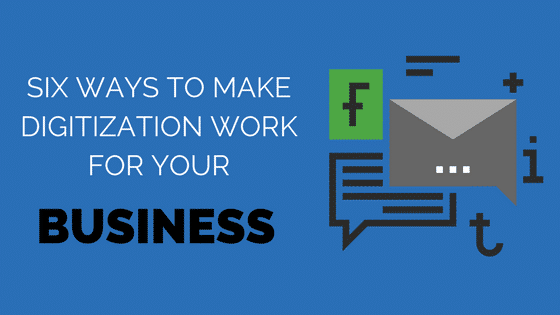Six Ways to Make Digitization Work for Your Business
Digital. Digitization. Digitalization. These are words we hear thrown around a lot in technology circles today. In my last blog post we talked about how Domino’s Pizza was one example of businesses leveraging technology to create value, but what does that mean for you and your customers? How can you create and implement a digital strategy that not only produces competitive advantage, but improves the customer experience? We’ve taken the time to develop six ways to make digitization work for your business.
Understand It’s a Way of Doing Business
The problem most of us have defining digitization is that we think of it as a thing. But it’s not a thing – it is a way of doing things, or more specifically a way of doing business. It is about growing revenues, controlling costs, and reimagining how we do business from the ground up. It is about redesigning process and retooling people to work more effectively within those processes. When executed effectively, digitization creates additional value in the products and services we offer, and uses them to improve the customer experience so that they’ll keep coming back for more. The best part is it’s all underpinned by technology.
Know What Your Customers Want
To develop a digital strategy, companies first need to understand what customers want and how to deliver it in the way that they want it, regardless of channel. This is a process with no distinct beginning or end, and it often involves all the business and the entire supply chain as well. Digital companies are gathering and analyzing data constantly so that they can adapt to the ever-changing needs of their customers. Domino’s knows that I’m most likely to order pizza on Thursdays because that’s when my wife and I go out to dinner and leave the kids with a sitter. Guess what? They send me a coupon every Thursday afternoon. It keeps me coming back for more.
Those that capture such customer insights create a tremendous competitive advantage for themselves. Those that don’t will struggle to survive. Take Uber, everyone’s favorite digital example. They created a piece of software that connects consumers needing a ride with otherwise idle resources: cars and drivers. They made it simple to order a car with a single click, choose the type of car, see where it is, and when it will arrive. They empowered the consumer by allowing them to serve as not just a passenger, but also the dispatcher. They don’t own cars or employ drivers, but the customer experience is vastly superior. So, the taxi industry, which has changed very little in the last 50 years, is struggling to remain relevant.
Make It a Priority
Based on these and numerous other anecdotes (Amazon, Airbnb, etc, etc.), developing a digitization strategy is something every company should be striving for, but is this the case? According to my research, Forbes lists digitization as the number one priority for CIOs in 2017. Interestingly, number two is customer experience, which is ultimately the goal of digitization. And, number three is data analytics: a tool to enable digitization that I’ll return to in just a moment.
Gartner takes this a step further. Based on their 2017 CIO Agenda survey, which polled 2600 CIOs from around the globe, on average 16% of revenues are currently derived from digital sources. Within five years that number is expected to more than double to 37%. In the same timeframe, we expect to see the digitization of processes increase from 42% to 77%. Clearly, digitization is the primary focus for CIOs trying to transform their businesses.
And this is not an easy journey, which is why many legacy companies are struggling to make the turn and why a startup without the baggage of decades of culture and process can show up and overturn an industry very quickly. CIOs are responsible for digital initiatives within their organizations and there is pressure to perform as digitization is now a mandate from the CEO. The CEO understands that if he or she cannot continually reinvent their businesses to meet the ever-changing demands of consumers, that someone else will and they will be marginalized. For this, the CEO turns to the CIO with the expectation that digitization initiatives will move quickly and evolve over time.
Unfortunately, many CIOs are struggling to leverage this momentum and find their place in this new digital frontier. Gartner’s data shows that only 39% of CIOs are responsible for digital initiatives. This means that the rest of companies either have no digital leadership, or it is being handled by the CEO, CMO, or CDO. Many CIOs now found themselves in transition, some might even say they are in a bit of an identity crisis. As the pace of technological changes increase and the drive to implement a digital strategy falls to them, they must reinvent their role to stay relevant. They can no longer simply be content with managing IT systems. For the enterprising CIO, however, this is an incredible opportunity to show their value, adapt to their new role, and become a strategic member of the CEOs inner circle.
Know Your Role
For the past few years, we’ve heard a lot of buzz about lines of business buying technology and shadow IT. As I think about this, I think we’ve missed the mark. Shadow IT and technology buying by lines of business are nothing but the results of IT’s failure to provide the business what it needs. The marketing department has no expertise in procuring and operating IT systems, nor do they have the desire to learn. If marketing is making technology purchases it is a sure sign that IT is misaligned with the business and are struggling to meet their needs. How can companies better align IT with the business? By facilitating conversations amongst the stakeholders, discovering the desired end state(s), and working backward from there to determine the optimal people, processes, and technologies to create this end state. If they do this, they keep IT relevant to the business, and the business remains relevant to their customers.
Reimagine How You Do Business
This requires a new way of thinking. In the digital world, companies can no longer operate in a linear fashion with discrete inputs and outputs to each process. In the digital world, the business is a platform and boundaries between internal departments, geographies, suppliers, partners, and customers are increasingly blurred. The business platform allows for dynamic connections between stakeholders that can be set up and torn down at will.
If this sounds a lot like a network, that’s because it is. The business has become a network of stakeholders that create value by using each other’s resources. It is through connecting these resources in new ways that innovation occurs. By conceptualizing the business this way, it is much easier to conceive new business models.
The effective CIO today must be fully integrated into the needs of the business and provide leadership and direction that aligns all human, capital, and technology resources to support these needs. Effective CIOs know they cannot pursue innovation without outside help. All surveys list recruitment of talented personnel as their number one challenge. Whether you hire or partner, you must solve the human resource challenges while furthering the development of IT’s impact on the overall business.
Understand Platforms Are Multifaceted
A platform is a group of technologies that are used as a base upon which other applications, processes or technologies are developed. It is the connection of small networks to make big networks. The network is the foundation upon which companies have built their businesses. Intelligent network platforms connect clients to servers, suppliers to consumers, departments, cities, countries. Unified communications platforms redefine how people connect with other people to explore, create and learn. Data center platforms connect users to information through software and store this information for analytics. And of course, keeping digital assets secure must be a key priority for every business or organization today.
Collectively, these platforms all enable the one goal all businesses care about: creating value for customers and shareholders by connecting resources in a unique way. This is the heart of digitization and it points to a future of unlimited potential for the companies that develop a sound strategy and execute quickly and effectively.
If you need help developing and implementing a digital strategy, shoot me an email at srollman@ineteng.com and let’s discuss. At IE, we have decades of experience building platforms and providing innovative resources and solutions that help businesses make the technology connections that matter most for their customers, stakeholders, and employees.
About the Author:
Sean Rollman has been helping clients conceive, implement and operate digial transformation strategies for nearly 20 years. In his current role as Chief Technology Office at Internetwork Engineering, Sean analyzes emerging technology trends and helps clients develop innovative way to use technology as a competitive advantage.
About Sean Rollman
Sean Rollman has been with IE since 2005 and has more than twenty years of experience providing the design, implementation, and management of complex technology solutions for mid-level and enterprise customers. His diverse background includes the development and oversight of voice, video, LAN, WAN, wireless, and data center solutions for customers across numerous verticals, both domestically and internationally.




